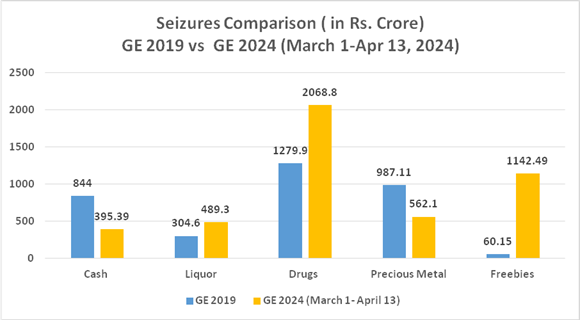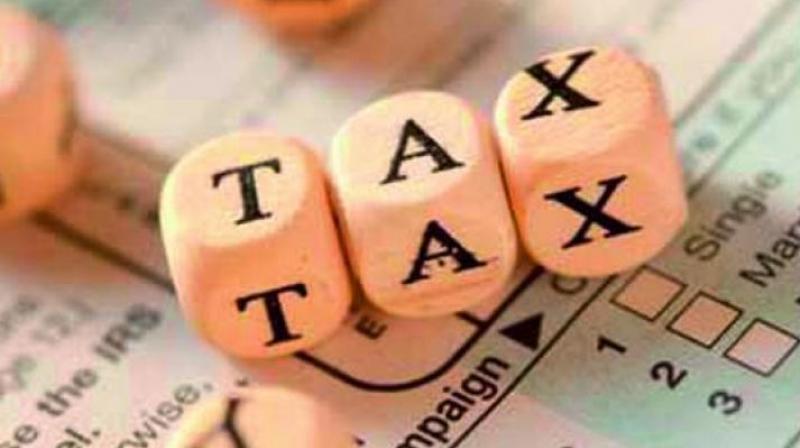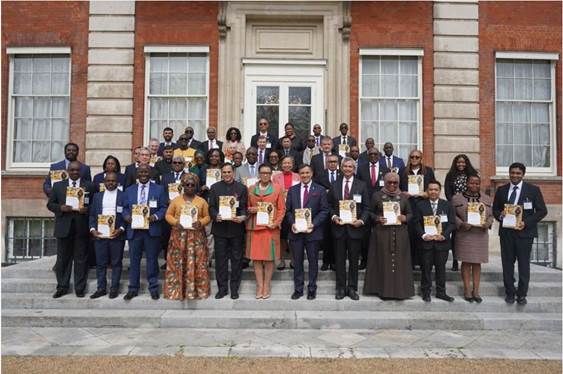ECI cracks down on money power: Rs.100 crore seizure each day since 1st March
Author: BI Bureau

New Delhi: With General Elections 2024 underway, ECI is on track for the highest ever seizures of inducements recorded in the 75-year history of Lok Sabha elections in the country. Enforcement Agencies have made a record seizure of over Rs. 4650 crores in ECI’s resolute fight against money power even before the first phase of polling for the 18th Lok Sabha elections commences on Friday. This marks a sharp increase over Rs 3475 crores seized during the entire Lok Sabha election in 2019. Significantly, 45% of the seizures are of drugs and narcotics, that are under the special focus of the Commission. The seizures have been possible by comprehensive planning, scaled up collaboration and unified deterrence action from agencies, proactive citizen participation and optimal engagement of technology.
Use of black money, over and above political financing and accurate disclosure thereof, may disturb the level playing field in favour of more resourceful party or candidate in specific geographies. The seizures are a critical part of ECI resolve to conduct the Lok Sabha elections free of inducements and electoral malpractices and to ensure a level playing field. CEC Shri Rajiv Kumar, while announcing the polls last month, underlined Money Power as one of the ‘4M’ challenges. On 12th April, Commission led by CEC Shri Rajiv Kumar along with ECs Shri Gyanesh Kumar and Shri Sukhbir Singh Sandhu reviewed all Central Observers deployed in Phase -1 of elections going to poll on 19th April. Tightening, monitoring and checking were amongst the focus of deliberations to ensure inducement-free electoral process.
The enhanced seizures reflect ECI’s unwavering commitment to monitor inducements and curb electoral malpractices for a ‘level playing field’, particularly in favour of smaller and less resourceful parties.
In an incident in Nilgiris, Tamil Nadu, the Commission suspended the flying squad team leader for laxity in duty and selective checking of a cavalcade of a prominent leader. Similarly, officials checked vehicles in the convoy of CM of a state and also vehicle of a Dy CM in another state. Commission has also taken strict action against approximately 106 government servants who have been found assisting politicians in campaigning, thereby violating the Code of Conduct and instructions.
In the press briefing during announcement of Parliamentary elections, CEC Shri Rajiv Kumar stressed in his presentation on strict compliance of BCAS instructions on surveillance and inspection of non-scheduled aircrafts and helicopters by Income tax, airport authorities and SPs of concerned districts, border agencies to keep close watch on international checkposts and GST authorities to closely monitor godowns, especially makeshift godowns meant for storing freebies. The Commission during reviews had always emphasized that there will be multi-pronged surveillance on all modes of transport - check posts and nakas for road transport, Coast guard for coastal routes and DMs and SPs alongside agencies for air routes including checking of helicopters and non-scheduled flights.
Details of State /UT wise and category wise seizures as on 13.04.2024 is placed at Annexure A.
How has it been made possible?
- Election Seizure Management System (ESMS)- breaking silos and bringing all enforcement agencies on one platform through use of technology is proving to be a game changer. With the introduction of technology in monitoring process, ESMS, an ECI in-house developed portal is proving to be a catalyst. The novel innovation for real time reporting of interceptions and seizures, avoiding duplication of seizures was tested in the last round of Assembly elections.
The portal facilitates digital trails and availability of seizure information at the click of a mouse enabling quick and timely reviews at all controlling levels. As per data, 6398 District nodal officers of various agencies, 734 state nodal officers, 59000 flying squads (FS) and Statics Surveillance Teams (SST) have been on boarded on ESMS platform for exhaustive real time monitoring and updates. All nodal officials have been trained on various aspects of using ESMS. The system took firm root during Assembly elections during 2023, when Rs 2014.26 crores was seized as against Rs 239.35 crores in the previous corresponding elections. With successful implementation and feedback from the field in the last round of assembly elections, it has been reviewed and made robust before implementation in ongoing elections.
- Meticulous and exhaustive planning, involvement of largest number of Enforcement Agencies: The largest number of enforcement agencies both from Centre and States have been assembled for collaborative effort among agencies.
- Months prior to elections and more intensively from January 2024, senior officials from the Election Commission visited every State and Union territory to emphasize the importance of combating the influence of money in elections. Furthermore, districts were thoroughly reviewed, and discussions were held with Chief Secretaries, Directors General of Police (DGPs), and heads of enforcement agencies to assess their performance and encourage heightened vigilance against the misuse of financial resources during elections. Field-level personnel are also subject to ongoing reviews by Chief Electoral Officers (CEOs), Observers, and District Electoral Officers (DEOs). Often, discoveries made by one agency ‘inform and guide’ the actions of others, leading to a unified and widespread deterrent effect. Commission has also emphasized the importance of joint teams comprising relevant agencies in inspecting inducements through various means—road, rail, sea, and air—during electoral visits to States/UTs. As a result, in January and February, the months preceding the official announcement, countrywide seizures totalling another Rs 7502 crores were recorded in form of cash, liquor, drugs, precious metals and freebies. This brings total seizure to over Rs 12000 crores so far with six weeks still left in the election period.
- Increased focus on drug menace in society: Notably, there was a substantial focus on drug seizures, which accounted for approximately 75% of the total seizures in January and February 2024. Chief Election Commissioner Shri Rajiv Kumar had emphasized the importance of agencies' efforts in seizing drugs and narcotics during his visits to nodal agencies. He highlighted that besides the risk of dirty money being used to influence elections, drugs pose a serious social menace with the potential to harm communities, particularly youth. The Commission has also collaborated with the Directorate General of the Narcotics Control Bureau and its senior officials to identify key routes and corridors for drug trafficking and ensure effective countermeasures are in place. Over the past few years, significant seizures have been made during elections to State Assemblies, including during the operation of Model Code of Conduct in States like Gujarat, Punjab, Manipur, Nagaland, Tripura, and Mizoram.
- Identification of Expenditure Sensitive Constituencies: 123 Parliamentary Constituencies are marked as Expenditure Sensitive Constituencies for more focussed vigil. These constituencies had either had a history of distribution of inducements in previous elections or have inter-state and international borders with potential inflow of drugs, cash, and liquor.
- Deployment of Expenditure Observers: Senior officers appointed as Expenditure Observers serve as the eyes and ears of the Commission for a fair and inducement free elections. A total of 656 Expenditure Observers have been assigned to Parliamentary Constituencies, while 125 are deployed in Assembly Constituencies across Arunachal Pradesh, Odisha, Andhra Pradesh, and Sikkim. Special Expenditure Observers with a brilliant track record of domain expertise and experience with election processes have also been deployed in States/UTs.
- Use of cVigil: cVigil app of the Commission has also reinforced the expenditure monitoring process through complaints directly from citizens on distribution of any type of inducements. Since announcement of election schedule, a total of 3262 complaints have been received pertaining to distribution of cash, liquor and freebies.
- No harassment to citizens: At the beginning of the current elections, there were reports in the media about tourists undergoing unnecessary checks and hassles by ground-level teams. Taking this matter seriously, the Commission promptly issued an advisory to all Chief Electoral Officers (CEOs) regarding the need for a careful and courteous approach when inspecting tourists and citizens. Additionally, the Commission directed the constituted 'District Grievance Committees (DGC)' to hold daily hearings at designated locations for the swift resolution of grievances related to seizures. CEOs and DEOs were instructed to ensure the effective functioning of these committees.
-
These measures serve as the cornerstone of a comprehensive expenditure monitoring process, resulting in increased seizures with least inconvenience to the public. With campaigning intensifying in the days ahead, the Commission stands prepared to enhance its vigilance to ensure an inducement-free electoral process in line with its commitment. /BI
More In Public Affairs
NEP-2020 aspires for inclusive excellence in school education
Rajeev Ranjan Roy
The New Education Policy-2020 (NEP-2020), unveiled recently, aims at achieving excellence in school learning by imparting quality, affordable and inclusive education to all, with an extra emphasis on those children coming from socially and educationally disadvantaged groups of the society. It is a futuristic endeavour towards building Ek Bharat, Shrestha Bharat. The previous education policies largely focussed on the issues of access and equity in giving school education, while the NEP-2020 commits to laying the foundation of a vibrant Bharat where no one is devoid of a kind of school education, which helps every student become an asset for the nation in a true sense. The unfinished agenda of the National Policy on Education 1986, which was modified in 1992, has been effectively dealt with in the NEP-2020 along with the vision behind the Right to the Free and Compulsory Education Act, 2009, which “laid down legal underpinnings for achieving universal elementary education.”
Given the undisputed role of education in nation building, the NEP-2020 rightly lays the stress on standardization and accreditation of school infrastructure and teachers as well, since education with accountability, transparency and affordability is the need of the hour, and hence the need to “empower schools, teachers with trust, enabling them to strive for excellence and perform at their very best, while ensuring the integrity of the system through the enforcement of complete transparency and full public disclosure of all finances, procedures and outcomes.” Since private sector is significantly present in the field of school education, the idea to promote ‘not-for-profit’ entities is a unique feature of NEP-2020, which at the same time intends to promote private philanthropic efforts for quality education, thereby affirming the public-good nature of education, while protecting parents and communities from arbitrary increase in tuition fees.
An equally important area, which has got due attention in the NEP-2020 is the need for efficient resourcing and effective governance through school complexes and clusters, a significant initiative in view of the fact that nearly 28 per cent of India’s public primary schools and 14.8 per cent of upper primary schools have less than 30 students. The average number of students per grade in the elementary schooling system – Grades 1 to 8 – is about 14, with a notable proportion having below six students during 2016-17, the year which also had 1,08,017 single-teacher schools, and majority of them – 85,743 – being primary schools taking care of Grades 1-5 children. It was, therefore, a pressing need to evolve a mechanism for establishing a grouping structure, say, school complexes, consisting of one secondary school together with all other schools, which lead to greater resource efficiency and more effective functioning, coordination, leadership, governance, and management of schools in the cluster. This will not only ensure optimum utilisation of resources, but will also foster the sense of oneness and togetherness among the school children, who are the future of the nation.
What further makes the New Education Policy-2020 uniquely special is its pledge for equitable and inclusive education for all, one of the great dreams of our founding fathers. Education, as the NEP-2020 rightly envisions, is “the single greatest tool for achieving social justice and quality.” Inclusive and equitable education, indeed an essential goal in its own right, is also critical to achieving a social order where every citizen has “the opportunity to dream, thrive, and contribute to the nation.” Quality, affordable and ethical education to all is the first move to break multiple social and economic barriers, which sow the seeds of exclusion, discrimination and exploitation against our own people on different parochial considerations.
Needless to say efforts were made in the past as well to bridge the educational chasm between socially and educationally disadvantaged groups (SEDGs) and the children of top social strata, but the desired results remained elusive. SEDGs account for the country’s overwhelming population, but their children’s share in quality school educational institutions has been minimal over the years. Early childhood care and education (ECCE) needs to be handled more comprehensively. According to the Unified-District Information System for Education (U-DISE) 2016-17 data, about 19.6 per cent of students belonged to Scheduled Castes (SCs) at the primary level, but this fraction fell to 17.3 per cent at the higher secondary level. These enrollment drop-outs were more severe for ST students (10.6 per cent to 6.8 per cent), and differently-abled children (1.1 per cent to 0.25 per cent), with even greater declines for female students within each of these categories. Thus, there is no scope for any complacency on the part of the government. A series of interventions including better facilities, more and more hostels, scholarships and other enabling support have been provisioned in the NEP-2020 so that the idea of ‘learning for all’ is realised in a more comprehensive manner.
Teachers are not only an integral part of an education system, but the most important stakeholder in the entire gamut of things. Their quality and ability to teach school students, when they are in their formative age, become something of paramount importance. From their recruitment to training, every precaution needs to be taken to ensure that school education is not rendered to a mere formality, but becomes a game changer. The New Education Policy-2020 comes with a basket full of tools and parameters to ensure holistic training and upgradation of teachers and their teaching skills in a sustainable manner. From continuous professional development (CPD) to career management and progression (CMP), the NEP-2020 vouches for a set of common guidelines – National Professional Standards for Teachers (NPST), which will be put in place by the National Council for Teacher Education (NCTE) in its restructured new form as the Professional Standard Setting Body (PSSB) under the General Education Council. This exercise will be carried out in consultation with National Council Educational Research and Training (NCERT), SCERTs, teachers from across levels and regions.
The teacher education will also undergo a sea-change. By 2030, the minimum degree qualification for teaching will be a 4-year integrated B.Ed. that teaches a range of knowledge content. Today B.Ed. teaching is most poorly regulated in our country ever since the standalone B.Ed. colleges were allowed to be opened up in the private sector. It is high time to take B.Ed. teaching more than seriously. The NEP-2020 stipulates that by 2021, a new and comprehensive National Curriculum Framework for Teacher Education (NCFTE-2021) will be formulated by the NCTE. NCFTE, which will also factor in the requirements of teacher education curricula for vocational education, will be revised once every 5-10 years.
In conclusion, the NEP-2020 visualizes to impart a school education which lays the foundation of a self-reliant India and also to help our country emerge as a knowledge hub. From the foundation of learning to foundational literacy and numeracy to checking drop outs and ensuring universal access to education for all and at all levels to the restructuring of school curriculum, India is in for a metamorphosis in the field of school education, recognizing, identifying and fostering the unique capabilities of each student. Tools such as multi disciplinarity, emphasis on conceptual understanding, creativity and critical thinking, ethics and human and constitutional values, full equity and inclusion, and light but tight regulatory framework are bound to do wonders. Education is a public service, a rare pursuit in nation building, which should be holistic and inclusive and must make one take pride in India and its rich, diverse, ancient and modern culture and knowledge systems and tradition. The NEP-2020 aspires so, indeed!
( The writer is a senior journalist and author. The views expressed are strictly personal.)
NEP-2020 aspires for inclusive excellence in school education
Rajeev Ranjan Roy
The New Education Policy-2020 (NEP-2020), unveiled recently, aims at achieving excellence in school learning by imparting quality, affordable and inclusive education to all, with an extra emphasis on those children coming from socially and educationally disadvantaged groups of the society. It is a futuristic endeavour towards building Ek Bharat, Shrestha Bharat. The previous education policies largely focussed on the issues of access and equity in giving school education, while the NEP-2020 commits to laying the foundation of a vibrant Bharat where no one is devoid of a kind of school education, which helps every student become an asset for the nation in a true sense. The unfinished agenda of the National Policy on Education 1986, which was modified in 1992, has been effectively dealt with in the NEP-2020 along with the vision behind the Right to the Free and Compulsory Education Act, 2009, which “laid down legal underpinnings for achieving universal elementary education.”
Given the undisputed role of education in nation building, the NEP-2020 rightly lays the stress on standardization and accreditation of school infrastructure and teachers as well, since education with accountability, transparency and affordability is the need of the hour, and hence the need to “empower schools, teachers with trust, enabling them to strive for excellence and perform at their very best, while ensuring the integrity of the system through the enforcement of complete transparency and full public disclosure of all finances, procedures and outcomes.” Since private sector is significantly present in the field of school education, the idea to promote ‘not-for-profit’ entities is a unique feature of NEP-2020, which at the same time intends to promote private philanthropic efforts for quality education, thereby affirming the public-good nature of education, while protecting parents and communities from arbitrary increase in tuition fees.
An equally important area, which has got due attention in the NEP-2020 is the need for efficient resourcing and effective governance through school complexes and clusters, a significant initiative in view of the fact that nearly 28 per cent of India’s public primary schools and 14.8 per cent of upper primary schools have less than 30 students. The average number of students per grade in the elementary schooling system – Grades 1 to 8 – is about 14, with a notable proportion having below six students during 2016-17, the year which also had 1,08,017 single-teacher schools, and majority of them – 85,743 – being primary schools taking care of Grades 1-5 children. It was, therefore, a pressing need to evolve a mechanism for establishing a grouping structure, say, school complexes, consisting of one secondary school together with all other schools, which lead to greater resource efficiency and more effective functioning, coordination, leadership, governance, and management of schools in the cluster. This will not only ensure optimum utilisation of resources, but will also foster the sense of oneness and togetherness among the school children, who are the future of the nation.
What further makes the New Education Policy-2020 uniquely special is its pledge for equitable and inclusive education for all, one of the great dreams of our founding fathers. Education, as the NEP-2020 rightly envisions, is “the single greatest tool for achieving social justice and quality.” Inclusive and equitable education, indeed an essential goal in its own right, is also critical to achieving a social order where every citizen has “the opportunity to dream, thrive, and contribute to the nation.” Quality, affordable and ethical education to all is the first move to break multiple social and economic barriers, which sow the seeds of exclusion, discrimination and exploitation against our own people on different parochial considerations.
Needless to say efforts were made in the past as well to bridge the educational chasm between socially and educationally disadvantaged groups (SEDGs) and the children of top social strata, but the desired results remained elusive. SEDGs account for the country’s overwhelming population, but their children’s share in quality school educational institutions has been minimal over the years. Early childhood care and education (ECCE) needs to be handled more comprehensively. According to the Unified-District Information System for Education (U-DISE) 2016-17 data, about 19.6 per cent of students belonged to Scheduled Castes (SCs) at the primary level, but this fraction fell to 17.3 per cent at the higher secondary level. These enrollment drop-outs were more severe for ST students (10.6 per cent to 6.8 per cent), and differently-abled children (1.1 per cent to 0.25 per cent), with even greater declines for female students within each of these categories. Thus, there is no scope for any complacency on the part of the government. A series of interventions including better facilities, more and more hostels, scholarships and other enabling support have been provisioned in the NEP-2020 so that the idea of ‘learning for all’ is realised in a more comprehensive manner.
Teachers are not only an integral part of an education system, but the most important stakeholder in the entire gamut of things. Their quality and ability to teach school students, when they are in their formative age, become something of paramount importance. From their recruitment to training, every precaution needs to be taken to ensure that school education is not rendered to a mere formality, but becomes a game changer. The New Education Policy-2020 comes with a basket full of tools and parameters to ensure holistic training and upgradation of teachers and their teaching skills in a sustainable manner. From continuous professional development (CPD) to career management and progression (CMP), the NEP-2020 vouches for a set of common guidelines – National Professional Standards for Teachers (NPST), which will be put in place by the National Council for Teacher Education (NCTE) in its restructured new form as the Professional Standard Setting Body (PSSB) under the General Education Council. This exercise will be carried out in consultation with National Council Educational Research and Training (NCERT), SCERTs, teachers from across levels and regions.
The teacher education will also undergo a sea-change. By 2030, the minimum degree qualification for teaching will be a 4-year integrated B.Ed. that teaches a range of knowledge content. Today B.Ed. teaching is most poorly regulated in our country ever since the standalone B.Ed. colleges were allowed to be opened up in the private sector. It is high time to take B.Ed. teaching more than seriously. The NEP-2020 stipulates that by 2021, a new and comprehensive National Curriculum Framework for Teacher Education (NCFTE-2021) will be formulated by the NCTE. NCFTE, which will also factor in the requirements of teacher education curricula for vocational education, will be revised once every 5-10 years.
In conclusion, the NEP-2020 visualizes to impart a school education which lays the foundation of a self-reliant India and also to help our country emerge as a knowledge hub. From the foundation of learning to foundational literacy and numeracy to checking drop outs and ensuring universal access to education for all and at all levels to the restructuring of school curriculum, India is in for a metamorphosis in the field of school education, recognizing, identifying and fostering the unique capabilities of each student. Tools such as multi disciplinarity, emphasis on conceptual understanding, creativity and critical thinking, ethics and human and constitutional values, full equity and inclusion, and light but tight regulatory framework are bound to do wonders. Education is a public service, a rare pursuit in nation building, which should be holistic and inclusive and must make one take pride in India and its rich, diverse, ancient and modern culture and knowledge systems and tradition. The NEP-2020 aspires so, indeed!
( The writer is a senior journalist and author. The views expressed are strictly personal.)



